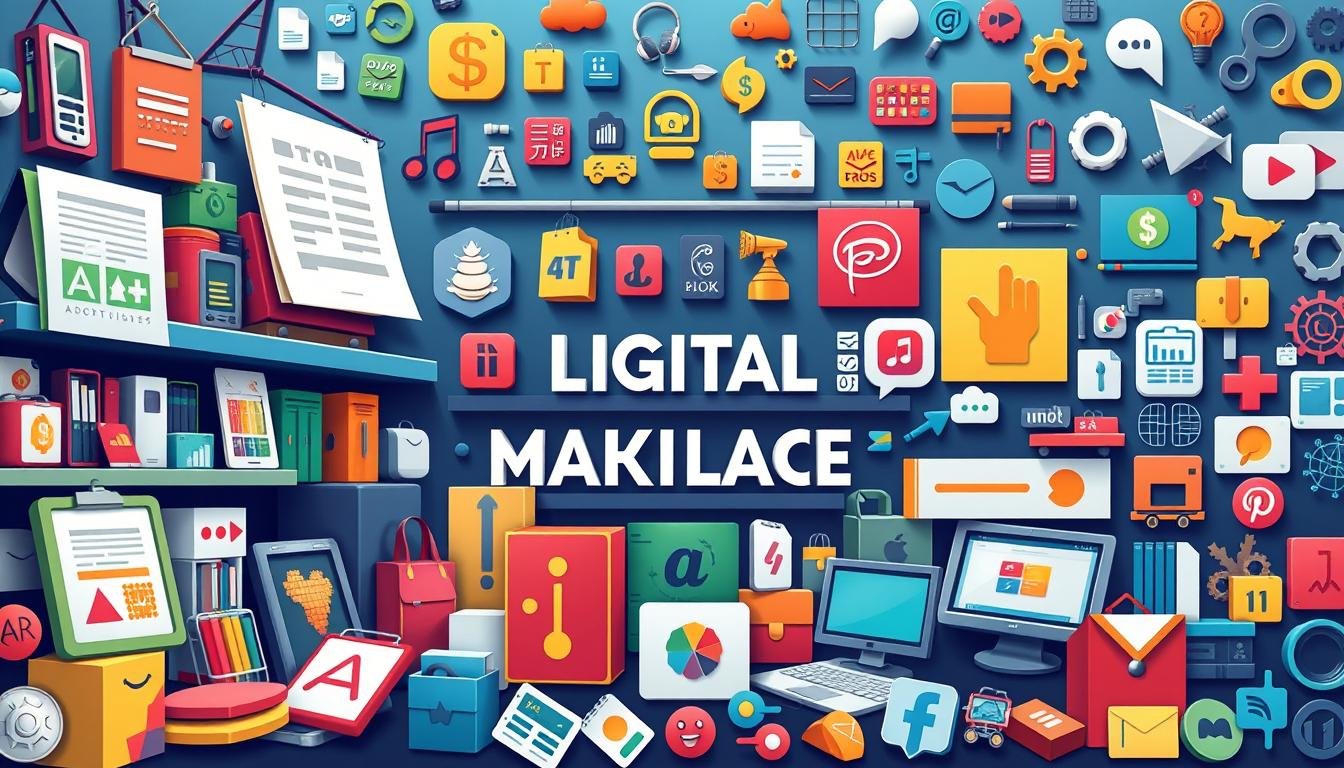Have you ever thought about why old-school retail is moving online? Selling digital downloads is more than a trend. It’s a new way to use your creativity and business skills. More and more people are seeing the good things about selling digital products.
Whether you make art, teach, or run a business, selling online has lots of chances to make money. It’s easy to start because there are no big costs. Let’s look at why selling digital downloads is so great, like saving money, making more profit, and reaching people all over the world.
Key Takeaways
- Lower overhead costs compared to physical products.
- Access to a global market, enhancing sales potential.
- Higher profit margins due to low production costs.
- Unlimited inventory with no stock management worries.
- Flexibility in product types and adaptation over time.
Understanding Digital Products
Digital products are a big part of today’s market. They don’t need physical storage, making them easy to manage. As more people shop online, knowing about digital products is key for creators and sellers. There are many types of digital goods, so it’s important to learn about them.
Definition and Examples of Digital Products
Digital products are items you can get online. They make life easier for both the people who make them and those who buy them. Here are some examples of digital products:
- eBooks: These are books you can read on your device, covering many interests.
- Online courses: They offer deep learning experiences for thousands of students.
- Printable products: Like coloring pages, fun for all ages.
- Digital templates: Tools to help you make professional documents.
- Licensing digital content: Such as stock photos and music, making money while you sleep.
Popular Digital Product Formats
There are many popular digital formats out there. They meet different needs in the market. Here are some:
- Audio files: Perfect for music, podcasts, and guided meditations.
- Graphics: Great for personal projects or professional presentations.
- Video courses: Engaging content for learning.
- Software applications: Tools to help you get things done faster.
Online education is booming, expected to hit $840 billion by 2030. This shows the demand for content like online courses. Creators can make the most of this trend and enter the profitable world of digital sales.
The Benefits of Selling Digital Downloads
Digital downloads are becoming more popular among entrepreneurs. They offer many benefits that can change a business. These include high profit margins, scalability, and global reach.
High Profit Margins and Scalability
Digital downloads can lead to high profits. The costs for making and selling them are much lower than for physical goods. There’s no need for storage or shipping, which saves money.
Businesses can grow their sales without spending more on operations. Automated systems help this growth without adding labor costs. Sellers can sell as many copies as they want, without worrying about running out.
Global Reach and Instant Accessibility
Digital products can reach customers worldwide easily. With just a few clicks, people from anywhere can buy products. This opens up many marketing chances across different platforms.
Understanding what customers want is key when selling digital products. This knowledge helps in making marketing more personal and building loyalty. Digital downloads keep their value over time, providing steady income for businesses.
Lower Overhead Costs of Digital Goods
Selling digital goods has big advantages, especially in lower costs. Unlike old-school retail, digital products don’t need a lot of space or inventory. This lets sellers focus more on creativity and marketing, not just keeping things running.
Reduced Physical Inventory Expenses
Digital downloads mean no worries about running out of stock. This makes it easier for more people to buy, without the fear of delays. Plus, there’s no need for warehouses or shipping, which saves a lot of money. Businesses can use this extra cash for marketing and growing.
Automation and Efficiency in Operations
Automating digital sales makes things much smoother. With systems in place for checkout and delivery, running a business is easier. This means less cost and more chance for passive income. Sellers can also use their existing fans to promote products, without a lot of extra work.
| Cost Aspect | Traditional Retail | Digital Products |
|---|---|---|
| Warehouse Fees | Required | Not Required |
| Shipping Costs | Necessary | Eliminated |
| Employee Salaries | Often Needed | Minimal Staff Required |
| Production Costs | High (materials & labor) | Low (digital creation only) |
Unlimited Product Types and Flexibility
The digital goods world is full of creativity and new ideas. Entrepreneurs can make many types of digital products, like e-books, online courses, software, and audio files. This flexibility in digital goods lets sellers meet different needs and grow their offerings. With digital products, businesses can easily start new income streams and change with market trends.
Types of Digital Products You Can Sell
- E-books – Share knowledge and expertise in written form.
- Online Courses – Educate and engage users through structured learning experiences.
- Software – Provide tools that solve specific problems or enhance productivity.
- Audio Files – Produce music, podcasts, or audiobooks for an audio experience.
- Templates – Assist users in tasks like design or business planning.
- Stock Photos and Graphics – Supply visual content for bloggers, marketers, or businesses.
Adapting Your Offerings Over Time
To stay relevant, you need to adapt digital offerings. Entrepreneurs can quickly make changes based on user feedback. Digital products can be updated easily and affordably. This lets businesses quickly respond to changing tastes and trends.
By constantly updating and adding new products, businesses keep customers interested. This approach also helps products stay relevant over time.

Building Your Brand with Digital Downloads
Creating a strong brand is key in the digital product world. Good marketing is crucial for attracting customers and making your brand known. By using different strategies, you can connect with your audience and build a community around your brand.
Effective Marketing Strategies
Using various marketing tactics can boost your brand and sales. Here are some effective methods:
- Social Media Promotion: Using platforms like Instagram and Facebook can showcase your products well.
- Email Campaigns: Personalized emails keep your audience updated on new products and deals.
- Influencer Partnerships: Working with influencers can help you reach more people.
- Limited-Time Discounts: Special offers can create a sense of urgency and encourage buying.
Creating Strong Customer Connections
Building strong customer ties can lead to loyalty and more sales. Here’s how:
- Exceptional Service: Great customer support makes buyers feel valued.
- Personalized Communication: Tailored messages can engage and build relationships.
- Community Engagement: Forums or groups for customers can create a strong brand community.
Tools like Canva and Adobe Premiere Rush can also help make your brand stand out online.
Exploring platforms like eBay or Etsy can also be beneficial. Each has its own rules, like Etsy’s $0.20 listing fee. Focusing on digital downloads can leave a lasting impression and grow your business.
| Marketing Strategy | Description | Benefits |
|---|---|---|
| Social Media Promotion | Engaging customers on platforms like Instagram and Facebook | Increased visibility and consumer trust |
| Email Campaigns | Sending personalized updates and offers | Improved customer retention and loyalty |
| Influencer Partnerships | Collaborating with influencers to reach new audiences | Enhanced credibility and wider exposure |
| Limited-Time Discounts | Creating urgency through promotional offers | Boosted impulsive purchasing |
Environmental Benefits of Selling Digital Products
Selling digital products helps reduce environmental impact. They don’t need manufacturing, packaging, or shipping. This cuts down on waste and saves resources. It shows businesses are committed to being green.
Reducing Waste and Resource Consumption
One big environmental benefit of digital downloads is less waste. Digital products don’t need raw materials or manufacturing. This lowers carbon emissions and saves resources.
- No physical waste from packaging or products that end up in landfills.
- Lower carbon emissions associated with production and transportation.
- Significant reductions in raw material consumption, facilitating a more sustainable model.
Promoting Sustainability Through Digital Sales
Businesses that focus on promoting sustainability in digital sales are becoming more eco-friendly. This improves their image and attracts customers who care about the planet. Key benefits include:
- A continuous stream of income through various digital formats like online courses, memberships, and subscriptions.
- The ability to reach a global market without geographic constraints, increasing opportunities for growth.
- High-profit margins due to the absence of manufacturing and shipping costs.
| Aspect | Traditional Products | Digital Products |
|---|---|---|
| Waste Generated | High (packaging, unused products) | Minimal (no physical product) |
| Carbon Footprint | Higher (transportation, manufacturing) | Lower (immediate download, no shipping) |
| Resource Consumption | Significant (raw materials required) | Negligible (no raw materials) |
| Initial Costs | High (manufacturing and shipping costs) | Low (just need digital setup) |
The digital market is growing fast. It meets consumer needs and supports a sustainable future. By choosing reducing waste with digital products, businesses can grow and protect the environment.
Challenges to Consider When Selling Digital Downloads
Selling digital downloads has its perks, but it also comes with its own set of challenges. The market is crowded, making it hard to stand out. Creators need to offer something unique and market it smartly to succeed.
Copyright issues are another big problem. Many sellers on platforms like Etsy face piracy, which hurts their profits. To protect themselves, they must register copyrights and use watermarks. This requires constant effort and resources.
Not being able to meet customers in person can also be tough. It makes building relationships harder. Sellers must work hard to connect with their audience and build loyal customers. Overcoming these hurdles is key to making the most of digital products.





